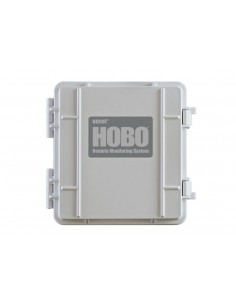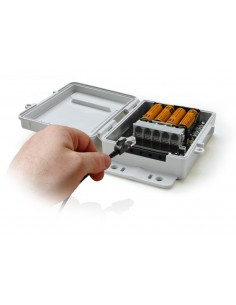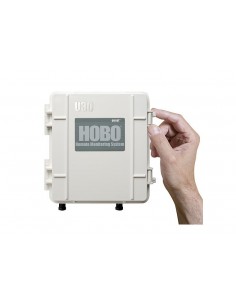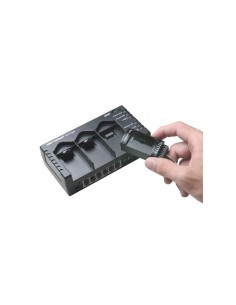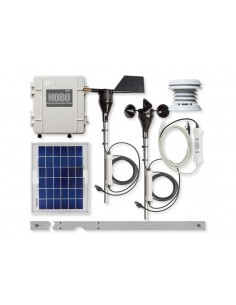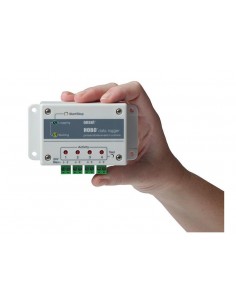The Contact Closure Pulse Input Adapter connects sensors with pulse outputs to data loggers with smart-sensor inputs. This smart sensor is compatible with contact closures, such as tipping-bucket rain gauges or reed switches with a maximum input frequency of 2 Hz (2 pulses per second), and a preferred switch-type of normally-open.
Highlighted Features
Plug-n-play adapter for pulse output sensors
Automatically recognized by H21, H22, U30, and ZW data loggers
Compatible with contact closures, such as tipping-bucket rain gauges or reed switches with a maximum input frequency of 2 Hz (2 pulses per second)
The S-UCD-M006 sensor supports the following measurements: Pulse Input and Water Flow
How the Pulse Recorder Works
A pulse recorder indicates the number of times an event occurred in a given time interval
The Pulse Recorder records the number of pulses that happen over a period of time. This device groups together or bins the number of pulses according to the time period they occurred in.
 Example:
Example:
If you are monitoring traffic through a door, the Pulse Recorder will log the number of times the door was opened during each interval:
1. The door opened 3 times between 9:30: AM and 9:31 AM
2. The door opened once between 9:47 AM and 9:48 AM
3. The door opened twice between 12:32 PM and 12:33 PM
The Pulse Recorder is most useful when you need the ability to collect rapid pulses that are too fast for the Event or State. It offers a more efficient way to collect information from a source which produces pulses at a constant rate. By binning the data without recording a time-stamp, the Pulse Recorder uses less memory than the Event or State.
Example:
Using the data collected in the above example, you can calculate additional data such as:
1. The door was opened for a sum of 8 times over the full period.
2. The average number of times the door was opened per minute is twice
3. There is more traffic through the door before 10:00 AM than after 12:00 PM
The Pulse Recorder requires a signal of at least 1ms duration and at least 8.33 ms between the leading edge of each pulse to be counted. If these conditions are met, then every pulse will be logged up to 65535 pulses per time interval.
Conversely, a pulse may not be recorded if it is less than 1ms or if more than one pulse occurs within a 8.33 ms period. If the latter happens, further data points may not be recorded until 8.33 ms after the first pulse.
A common application for the Pulse Recorder is to measure the flow rate or total volume of a pipeline. The Pulse Recorder collects pulses generated by a flow meter and uses that information to calculate the number of gallons per minute. The flow meter produces a pulse that is too rapid to be collected by the Event or State, yet can easily be binned by the Pulse Recorder. The important data here is not the exact time when the pulse took place, but rather the number of pulses in a time interval.
Maximum input frequency: 2 Hz (2 pulses per second)
Measurement range: 0 – 65,533 pulses per logging interval
Resolution: 1 pulse
Lockout time: 327 ms ± 10%
Recommended input type: Mechanical contact closure (example: reed switch in a tipping-bucket rain gauge)
Preferred switch state: Active low input Normally open
Edge detection: Falling edge, Schmitt Trigger buffer (logic levels: low ≤ 0.6 V, high ≥ 2.7 V)
Minimum pulse width: 1 ms
Input/output impedance: 100 KΩ
Open circuit input voltage: 3.3 V
Maximum input voltage: 3.6 V
User connection: 24 AWG wires, 2 leads: white(+), black(-)
Operating temperature range: -40° to 75°C (-40° to 167°F)"
Overall cable length: 6.5 m (21 ft.)
Housing: Weatherproof PVC housing protects input adapter electronics
Housing dimensions: 14 x 0.95 cm (5.5 x 0.375 in.)
Weight: 310 g (11 oz.)
Bits per sample: 16
Number of data channels: 1
Measurement averaging option: No (reports the number of pulses over the logging interval)
You might also like
HOBO USB Micro Station Data Logger
HOBO U30 USB Weather Station Data Logger
HOBO U30 USB Weather Station Starter Kit
HOBO 4-Channel Pulse Data Logger
Electronic Switch Pulse Input Adapter - 1m Sensor
Contact Closure Pulse Input Adapter - 1 meter Sensor
Chat with us on WhatsApp



